Urban sailboats, the transport of the future, or the taming of monocolos

Technical progress now often makes pleasant surprises. You live for yourself, you live, then you learn on the Internet about a funny thing, you buy and change your life. A monowheel or electric self-balancing unicycle has outgrown the level of the toy and makes a serious claim to becoming the city transport of the future, having pressed bicycles and scooters.
Glosse Kuzdra
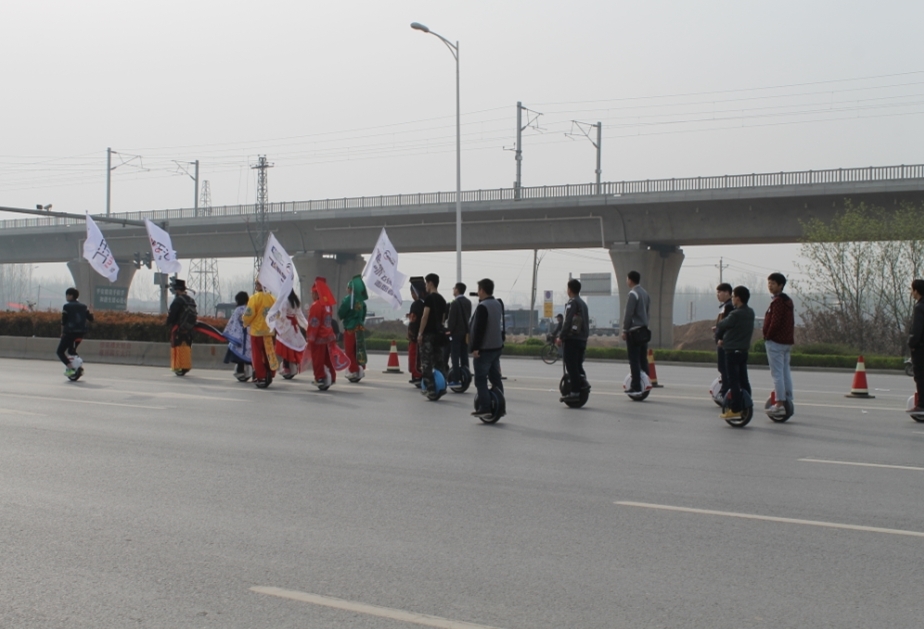
Monocoles are regularly confused with hovercraft, segway and even vacuum cleaner robots. Therefore, it is necessary to tell in detail what it is. Structurally, the monowheel is a wheel with an electric motor (motor-wheel), which takes energy for battery operation and is controlled by the controller.
')
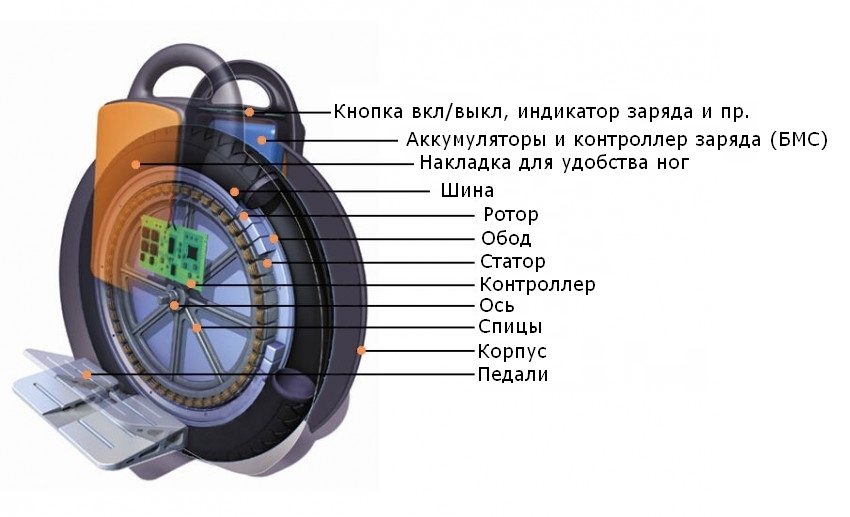
The controller, using gyroscopes, knows its position in space, and with the help of Hall sensors, the position of the wheel relative to the body. Based on this information, the controller solves the problem of the inverse pendulum (the same as holding the pencil with the tip on the finger), turning the wheel so that the pedals with the body stand horizontally along the longitudinal axis (back and forth). On the transverse axis (tilt left and right) the monowheel is controlled by the person who rides on it. A little distracted from the topic, the task of the inverse pendulum is quite often found in technology, for example, the control system of a space launch vehicle solves it with great accuracy.
In simple terms, the included wheel tends to "drive up" under the rider, while allowing you to tilt yourself left and right. For acceleration, you need to move the weight forward, for braking - back, and you can turn the wheel tilt.
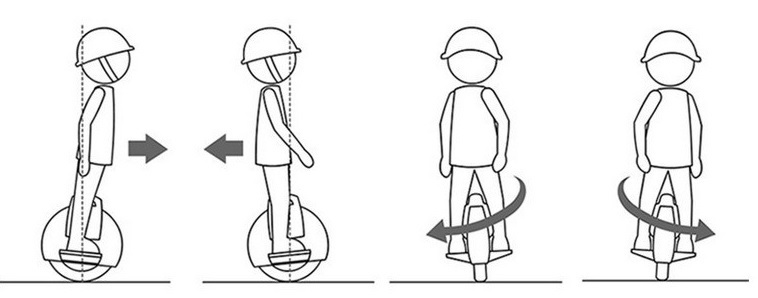
Segways differ from monowheels in that they are balanced in two axes, have two wheels and turn with a handle.

Girokutera differ from monowheels in that they have two wheels, which are separately controlled by turning the pedals.
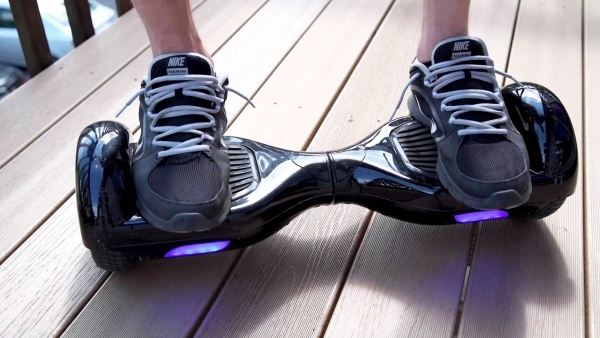
There are also single-wheeled motorcycles (monocycles) with a steering wheel and a seat, one-wheeled self-balancing boards and other exotics.
History of monocolos
The history of monocoliles is quite instructive.
Humanity has invented a variety of one-wheel devices for a long time, but all of them were rare because they lost in functionality. They were big, badly turned, accelerated and braked, or had other shortcomings.
One of the first patents dates back to the mid-19th century, but outright loses the bike for convenience.

In the 20th century, units with a motor appeared, but they, in turn, lost to motorcycles.


In the 1960s, Charles Taylor developed a self-balancing single-wheel unit, he drove pretty well, but had to use a blower for balancing in the longitudinal axis.
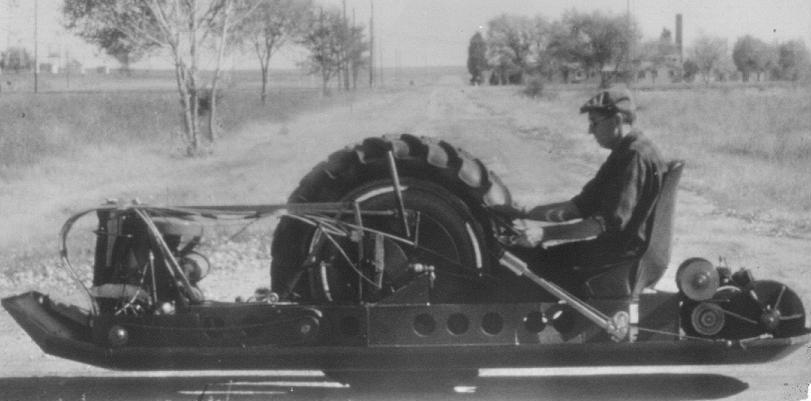
Well, the whole 20th century people used to ride unicycles in circuses. In addition to circuses, alas, the devices got acclimatized badly - not everyone is willing to learn to ride them for months, and they also lose the convenience of bicycles.
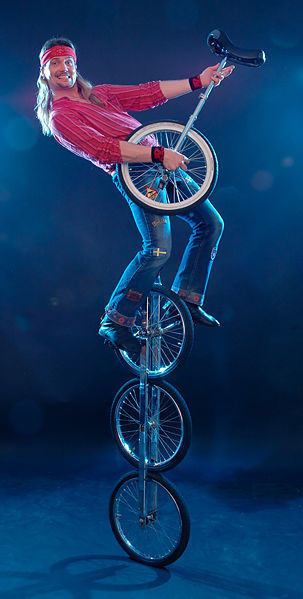
At the same time, in 1978, a patent was issued that surprisingly resembles a monowheel.
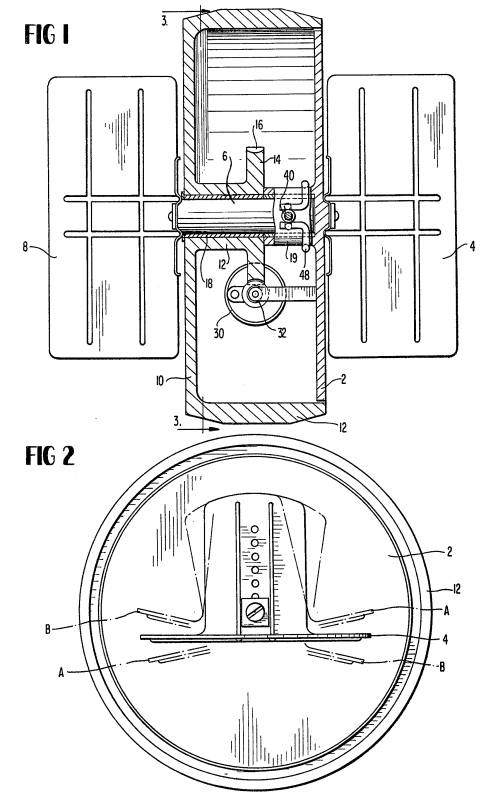
This device had almost everything that was needed - an electric motor with batteries, a small wheel and pedals on which a person would stand. But in the 70s, gyroscopes and control microcomputers were used by the military and aerospace industries and were very expensive. Therefore, the inventor decided to give all control to the person. Through a special rod, which was, in fact, a variable resistor, the inclination of the pedals turned into an electric motor force.
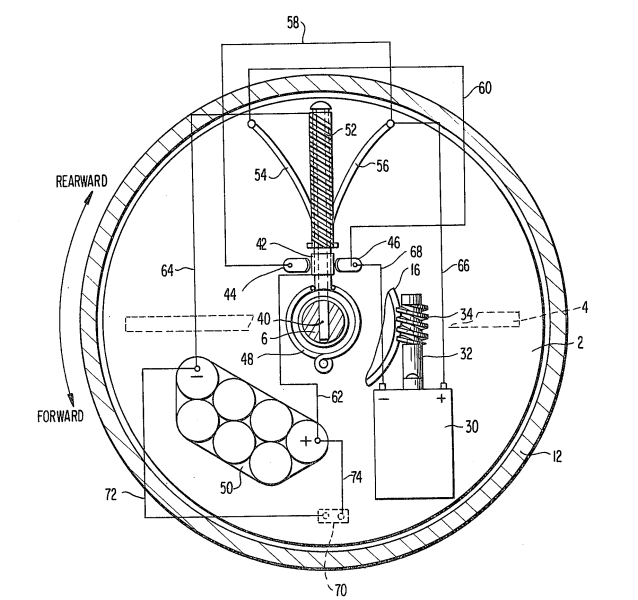
It is impossible to find a video of the trip on such a device, but, most likely, because of the imperfection of control, it would have had to swing back and forth. The motor, by the way, was also chosen poorly - a worm gearbox was used to drive the wheel.
In 2006, a patent was filed for a unit with a control system for accelerometers and a fantastic even today weighing 4 kg.
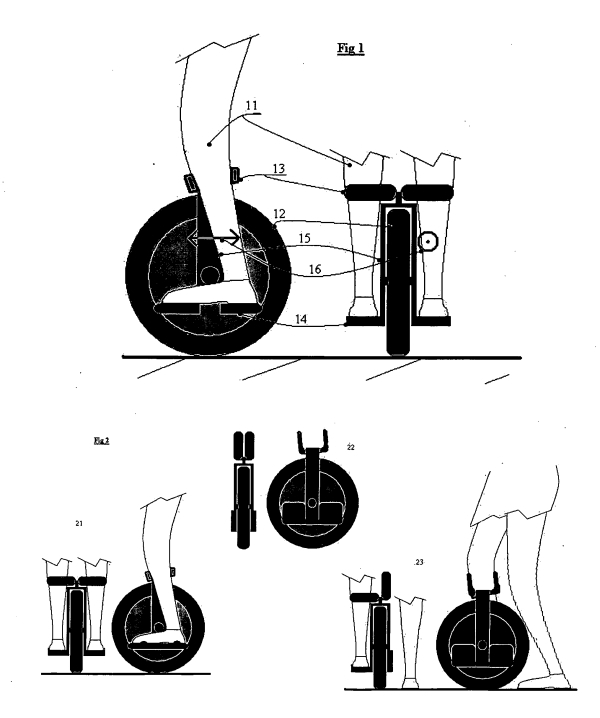
In all but the unnecessary leg fixers, this design has overtaken its time. It is still not possible to place the engine, battery and controller inside the wheel. Perhaps in five or ten years, similar constructions will appear.

In parallel with these patents, which could only exist on paper, working devices began to appear at the turn of the century. The first were the Segways who caused a sensation in 1999-2000. A new means of transport was predicted for the total crowding out of all others, but, as we know, this was not to be. The original segways had a price that was completely inadequate for mass popularity. In addition, they were not particularly compact, had low speed and throughput. Now, fifteen years later, the segways occupy a rather small niche of recreational devices, and the developer company of the original segways was recently bought by the Chinese company Ninebot, which began with the manufacture of monocarves.
The technology was almost ready to slip - companies and individual inventors began to appear who combined a motor-wheel, a controller with gyroscopes and lithium-ion batteries. Trevor Blockwell created Eunicycle.

Alexander Polutnik - Enicycle

Focus Designs has made SBU and even taught Adam Savage to ride it from Mythbusters.
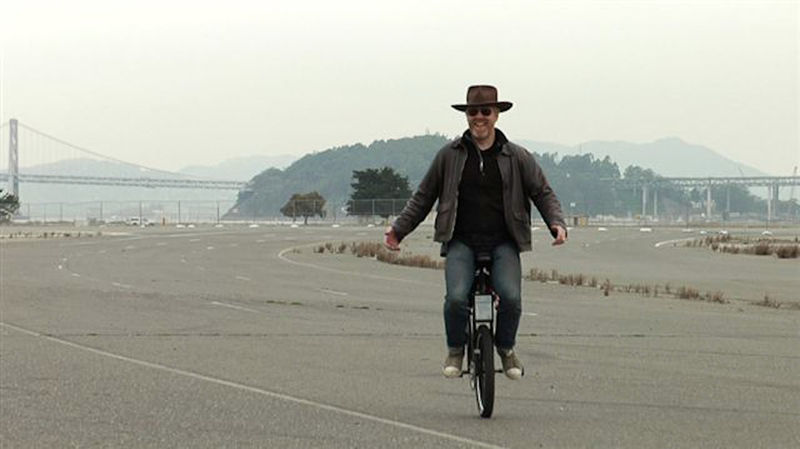
But all these inventors, first, went through the evolutionary way, developing the idea of a unicycle with a seat, and secondly, they could not begin mass production. The last two steps to the realization of the idea of the monocolice were made by Shane Chen with the company Inventist, who, firstly, threw the seat out of the design, and secondly, managed to start production in volumes large enough to make the monowheels become a noticeable device. So the solowheel monowheel was born (2011 patent)
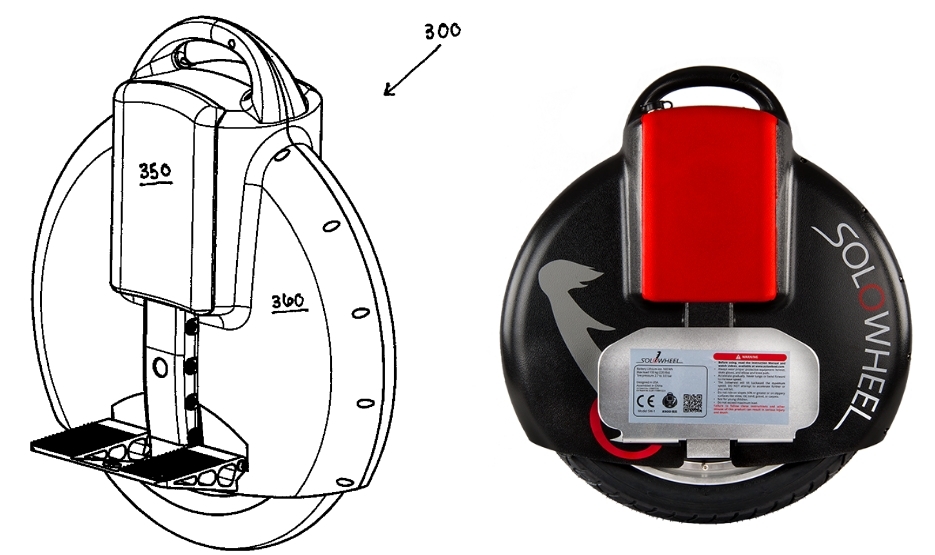
The rest of the story is a bit sad. It seems that after the initial success, Chen chased the perfect design instead of production. At least two models, the Spirit and the completely futuristic Orbit, which were shown at exhibitions, did not appear in the series.

And in 2016, the Solowheel product range is limited to just two models that are already morally obsolete. Several Chinese companies, starting with direct copying of the first monowheel, are now massively producing wheels, which are several times cheaper, superior to the original in speed and range, have a different design for different tastes and many additional amenities. Do not be surprised if soon the company Inventist, as well as the developer of segway, someone buys solely for the sake of patents.
Monowheels today
Current models of 2016 can boast the following characteristics:
Speed: Hits of the season allow you to accelerate to 40 kilometers per hour, old or cheap models have a maximum speed of 15-20 km / h. The specificity of the design - the fact that the wheel tends to drive up under the rider, means that you can try to accelerate above the maximum rating speed, but at the expense of safety loss. The wheel will squeak, lift the pedals, signaling that the maximum speed has been exceeded, and, at some unpleasant moment, failing to drive up in time under your feet, will drop the hardtop. Do not do this.
Power: Leaders are hiding "under the hood" and a half kilowatts, which you can safely enter the steep hill. On the controllers of most of the wheels are capacitors, which can provide a peak power of 2-3 kilowatts for a hummock or a border. The cheapest wheels use 350 W motors, which is not safe - such a wheel can drop a rider on a hummock or ascent. Safe driving starts at about 500-800 watts of power.
Power reserve: The maximum range has now exceeded 100 km. Using an approximate formula, you can calculate the power reserve as the battery capacity in watts * hours / 10 - 5. That is, a wheel with a 340 W * h battery will be able to drive approximately 340 / 10-5 = 29 km. These are approximate figures, the real ones depend on the rider's weight, riding style, average speed and temperature outside (there is a more advanced calculator ). Typical are battery assemblies for 340, 480, 680, 820, 1360, 1600 Wh. It is also worth noting that when batteries are charged below 30%, the maximum speed at the wheel decreases - discharged batteries cannot guarantee the power needed for fast driving.
Wheel diameter: Typical values are 14, 16 and 18 inches. Large diameters improve maneuverability, small diameters provide better maneuverability.
Weight: Usually in the range of 12-23 kg.
Price: In the range of 30-80 thousand. Solowheel wheels stand apart with a price tag of 100 and 150 thousand and very cheap wheels, which, rather than the pleasure of a trip, are more likely to deliver some problems.
Extra amenities . To facilitate life and increase driving pleasure, quite a lot of technological solutions were created.
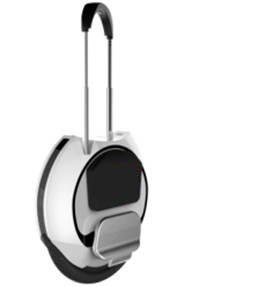
A pen. In order not to carry twenty kilograms in their hands, some models have a built-in retractable handle, with the help of which it is very convenient to roll the included wheel. It can be added to the wheels without a built-in handle. The complexity of this addition depends on the model - somewhere there are branded pens sold separately, somewhere you need to drill the case and put the handle on the screws.
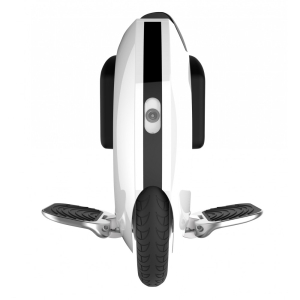
Headlights and dimensions . For driving in the dark, the wheels may have built-in headlights and side lights with braking indication, like on a car.
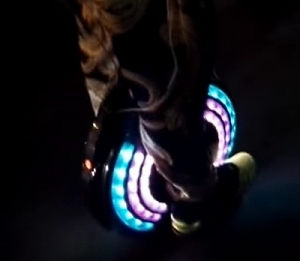
Side lights. In addition to increasing the visibility of the rider side lights may just like someone.
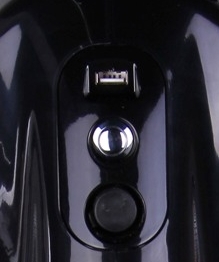
USB port. In some models there is a built-in USB port for charging gadgets from powerful wheel batteries.

Off button when carrying . Lifted into the air, the monowheel begins to spin, trying to stabilize. In order to avoid such inconvenience, in the handle of some wheels there is a special button that automatically turns off the wheel when it is taken by the handle in order to transfer.
Bluetooth speakers. Riding on the wheel in the headphones is not safe. Therefore, quite often there are built-in speakers to which you can stream music from your phone.
Applications for the phone . The advanced wheels have applications for IPhone and Android, in which you can see the motion parameters, statistics and perform some settings. Very comfortably.
Reflections on the future
With such a pace of development of electric transport, the bicycle will have to seriously move around in the city. And the monowheel is one of the competitors to the place of the ideal last mile urban transport. As a matter of fact, in my opinion, monowheels have only one serious opponent - the electric scooter. Let's take a closer look at each view.
Monowheel.
- The most compact in linear dimensions, perfectly fits in any public transport.
- Travel speed is on average faster than regular bikes.
- The trip does not require much physical effort even on hilly terrain; if you go to work, there is no need for a shower.
- The price is comparable with electric bicycles.
- Lighter than electric bikes.
- Looks stylish
- Body control is as close as possible to thought control - there are no gas knobs / knobs and other things.
- The monowheel does not need bicycle parking, is located next to the owner, and, therefore, is not afraid of bicycle thieves.
Electric Scooter
- In terms of volume, it is comparable to a monowheel - a longer one, but when folded, it has a very small height.
- Travel speed is slightly less, or comparable to the monowheel.
- Also does not require much physical effort when traveling.
- A bit cheaper monocolice.
- On average lighter than monowheels.
- Does not require training.
- It has a slightly lower permeability and is more sensitive to the coating than the monowheel due to the smaller diameter of the wheels.
- Also located next to the owner and does not need parking.
Other means of urban transport are losing. A full-size bicycle will not fit into a small bus and will hardly fit into a large one, it requires considerable physical effort, especially a hill. A folding bike the better it folds, the worse it rides. The electric bike is the fastest, but on average the most expensive and the heaviest. And if you have not learned to ride in childhood, then the duration of training is comparable or more than for monowheels. The motorless scooter is cheap, it goes well with public transport, but is unsuitable for long distances.
All of these modes of transport are about equally vulnerable to bad weather or winter. Some enthusiasts ride bicycles or monowheels in winter, but this is not likely to be a mass phenomenon.
Monocolice weaknesses
The fact that the wheel is independently balanced provides not only advantages, but also weak points. The monowheel, like other self-balancing devices, can be “pushed through” by leaning too hard, overload the engine and fall off the pedals. The solution of the inverse pendulum problem requires adhesion to the surface - the monowheel starts to unwind, if it is lifted into the air, and turns off upon reaching the maximum speed. For the same reason, it will not be possible to drift on the monowheel, and it does not like spinning. Because of this, for example, you will not be able to ride on the deep soft sand, where the wheel will begin to burrow, slip, and drop the rider. Problems can also occur with deep mud or ice. But a small layer of sand or dirt on the solid surface of the monowheel passes without any problems, and again, its permeability can be compared with the bike (except for special models such as fatbikes).
A separate feature of monococks is sensitivity to a sudden load. Particularly unsuccessful models of controllers can burn from a branch on the road, there have been cases of failure of wheels when trying to drive from the place to the curb. In some models there are fuses (ordinary car 40 A), which protect the controller, but the blown fuse means the end of the trip and repair at home - models with quick replacement are not yet released. I once had a fuse blown when the wheel was lifted onto the curb and began to slip in an inclined position on a slippery surface. But, given the youth of the very idea of a self-balancing device, I think in the future we are waiting for new algorithms and controllers in which this problem will be finally solved.
Taming monocolice
In the middle of the 19th century, the bicycle was a new device, and adults learned to ride it. Mark Twain experienced the delights of learning to ride a bike and wrote a wonderful story "The Taming of a Bike . " Today, most people learn to ride a bike as a child and already remember the process poorly. In addition, difficulties and injuries are smoothed out by childish enthusiasm and a lighter attitude to life. In the 21st century, the monowheel takes about the same position as the bicycle a hundred and fifty years ago - serious adult uncles learn to ride it. Of course, I am not Mark Twain, but I hope my experience will amuse you and be useful when you want to learn how to ride a mono-wheel.
Days -7-0. The wheel is selected, bought and goes to Ufa. While waiting, the topic is being studied on the forum on how to learn to ride, and there is a video:
From the theoretical point of view, the algorithm looks perfect - without additional devices, consistently, from simple to more complex, and avoiding the situation “I can go, but I don’t know how to start and dismount”. The forum writes stories about how people learned to ride for half an hour, the task does not look any complicated. I optimistically decide that in a couple of days I will learn to ride and ride to work (15 km one way).
Day 1, Saturday. The wheel is covered with a protective tape from scratches when falling and pulled out to the park. In Ufa, the whole of August is hot for thirty, so the very first minutes put me on the verge of heat stroke. And the site chosen is very small, it is extremely difficult to learn from. OK, I will get up earlier, and walk in the morning, while it is not quite hot. The duration of this and subsequent workouts is an hour and a half.
Day 2. The playground is empty, with +25 you can train more or less. But still hard. The wheel seems very heavy, constantly trying to fall aside. To hold the wheel with my foot is painful and unusual, so I am changing my leg, summing up this ideological basis, that I may be ambidexter.
Day 3. On the forum, they write about hefty bruises on their lower legs during training, some even buy lining. But if you are afraid of this and do not press your legs tightly, then you can’t really manage the wheel. By the way, I never had bruises on my shins.
Day 4. More than four hours wasted make us start to seriously doubt our abilities. Because the training is sad - for an hour every day, without any success, I try to learn how to take a long step and go to ride on one leg. No, I, of course, can jump onto the wheel with one foot and drive a meter, but 110 cm or a second later I clearly understand that there is no possibility to go further. It is more convenient to start from the left leg, but when I change it to the right leg at the end of the workout, it starts to seem like I can almost go. It was decided to change the leg.
Day 5. The biggest achievement is to get on the wheel with one foot, to have time to rejoice that you have been driving for the second second, and then fly off from it.
Day 6. Six hours of training. No, I am still positively the most talented person on the globe and I can easily get the dubious laurels of the only idiot who failed to learn how to ride a mono-wheel. Progress? Wonderful - the wheel that came out from under the feet stripped the shoe, and in a couple more attempts I got very painful with the pedal to my foot. Near the bone on the leg a large bruise matures.
Day 7. I am probably a mutant. My center of gravity is located twenty centimeters to the right of the right shoulder. If I start with my left foot, I fall to the right. If the right - it is also right. But for the fourth hour the Indian Zorky Eye noticed that the shed has only three walls - if you fold one pedal (I still train a long step on one leg), then it cannot be hurt the leg.
Day 8. Probably, there is some flaw in the teaching method, or it does not suit me. I will mobilize my wife for help and train another way - get up on the wheel with two legs and ride, leaning on her shoulder. In order to ask for help on the forum, I record a video - what if they notice my mistakes?
But after recording this video, walking in a circle with support on the shoulder of my wife gives their results - I begin to make a snake, and, coming off, I can drive about five meters. Win!
Day 9. Hurray, I can drive for a minute, and starting off myself! It is necessary to record a video.
The video is not noticeable, but here I drive like a circus horse - in a circle. I turn the turn completely unconsciously, to the left, and I don’t understand how to go straight or turn right. But in an hour, with strong-willed efforts, I’m making right turns and even get out of my way along the bike path in the park.
Day 10. Well, here everything is simple. 15 minutes to remember how to start and turn right (be prepared, at first the skill will be slightly forgotten), and I already drive along the paths, listening to the praises of retirees who watched my morning sufferings.
Conclusion: On the wheel, you can learn to drive fast, I just learned by a method that is not appropriate for me specifically. Start with a compass, try to do a long step, it is useful for starting and stopping, and then, if it does not work out, learn to ride with a support. Well, having an experienced instructor helps a lot - I managed to teach a ride in a straight line (without turns) of an acquaintance in an hour.
Monokolis and traffic
In the coming years, the SDA will have to be edited, because the mono-wheels, segways, hoverboards or electric scooters do not fit into the modern edition at all, but are becoming increasingly popular. One-wheeled vehicles in the SDA are not mentioned at all, and this is logical, because unicycles were very rare. If you do not take into account the number of wheels, the maximum speed of up to 50 km / h and the engine capacity of up to 4 kW monowatt turns moped. And this is no good, because on the roadway mono-wheeled and electric scooters have nothing to do. Reducing the power to the level possible for 250 W for bicycles on the road to fit them into bicycles will make the wheel unsafe. The ban on electric transport, as was done in the UK, Prague or Beijing is stupid, and will not stop progress. One can only hopethat the path to the usual vehicle will not be difficult for electric vehicles.
Security measures
Kinetic energy is proportional to the square of the speed. Therefore, on modern fast wheels a drop at a speed of 30-40 km / h can lead to serious consequences. According to statistics, palms, elbows, and knees are most often affected, so for traveling on a mono-wheel, take some money and buy roller protection. If you fall at a low speed, you can get rid of abrasions, but in this case, protection will pay off, keeping your clothes intact. There are disputes about the need for a helmet, but it will not be superfluous - the head is usually a very valuable part of the body. Motorcycle jackets and "turtles" are still superfluous, although, if the new wheels become even faster, you will have to think about them.
You should not listen to music with headphones and, especially, look at the phone when you drive. This lowers the awareness of what is happening around you, and in the event of a fall, the phone will definitely jump out of your hands and break. Sorry.
Economic component
Knowing the approximate mileage on a single charge, the battery capacity and the cost of a kilowatt * hour, you can calculate the consumption in rubles per kilometer. For example, approximately 30% of my battery is spent on work for 30 km and back. 0.34 kWh (I have a 680 Wh battery). Therefore, I will spend 0.011 kW * h per 1 km, and the price of one kW * h at 2.74 rubles will give me a kilometer cost of three kopecks. In reality, there will be losses on the charger and stuff, but one kilometer will cost no more than five kopecks. If desired, you can even count the payback. If I spend on the road there and back 50 rubles by public transport and 1.37 rubles on a mono-wheel, then a wheel worth 54,000 will pay off in 1,110 days or three years. These, of course, are not realistic numbers, but when compared to a taxi, the monowheel will pay for itself in just one season of ~ 130 days. Clear,that the payback figures are speculative, but the electricity for the wheel really costs literally a penny. Taking into account the absence of emissions from driving and the low consumption of resources for the production of the monowheel, it turns out to be extremely environmentally friendly.
Personal experience
I have been driving a mono-wheel since the beginning of August, I have driven about 600 km This is an amazing experience. The wheel feels almost like a part of the body and is driven almost by thought. When driving, it creates an amazing feeling of walking and traveling at the same time, and for the monocolos one would like to use romantic allegories of a planning flight or sailing. 15 km to work and back I drive a little slower than public transport (about an hour versus 40-50 minutes by bus) thanks to the cycle path through the whole city. With an average ground speed of 17 km / h, I overtake not only cyclists, but even trolley buses and slow buses.
And here is a walk on the mono-wheel through the city. Ufa is a very green and beautiful city, and I tried to drive past the sights.
In Russia, a community of mono-classists lives on the forum of electric vehicles .
The second monowire competition will take place on September 25 in Moscow . Admission is free, but registration is required . If you are interested, you can chat with enthusiasts monocoles.
Source: https://habr.com/ru/post/369615/
All Articles